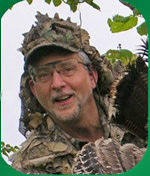To Blaze (Orange) or Not To Blaze...That is the Question!
by Ed Migale
Working my way in the dim half-light of pre-dawn I eased to a vantage point above the edge of a snow-blanketed basin in northwestern Colorado. From afar I had glassed several mule deer – including one good sized buck -- feeding in this basin the evening before.
My guess is that they would still be nearby and if I could get into the area without being detected, I might have a decent chance of putting myself within rifle range of that buck. My strategy was to go all the way up to the top of the basin’s chute, then glass the entire zone below.
But when I peeked over the ledge just after daylight – and a few hundred yards from my intended destination -- my heart sank. On the far ridge, half a mile away, the tell-tale blaze orange hue of another hunter immediately caught my eye. Obviously, we both had designs on this area, but had approached from opposite directions.
I eased back from the edge and considered my options. The other hunter appeared to be just sitting there. If I stayed put, I could still glass a significant portion of the basin. Which is what I did and two hours later I attached my tag to a terrific 4X4 muley.
There are several good reasons to wear blaze orange while big game hunting and the above listed tactical example is just one of them. Seeing that hunter caused me to adjust my plan. Had I not seen him, I would have continued up the ridge and likely messed-up both of our hunts.
Obviously the safety factor is another reason to wear blaze orange. Common sense dictates that visual confirmation of another human being prohibits shooting in that direction. A number of state game departments feel this is important enough to require that hunters wear some type of blaze orange, with different states having their own unique regulations. For example, Colorado requires that hunters wear an above-the-waist outer garment with at least 500 square inches of solid (not camouflage) daylight fluorescent orange material, with at least part of those 500 inches being comprised of a hat visible from all directions. Wyoming simply requires its big game hunters to wear, in a visible manner, some form of blaze orange garment.
“We have a very low accident rate in Wyoming,” said Al Langtson, an Information Specialist with the Wyoming Game & Fish Department. “While much of that can be attributed to our aggressive hunter education program, we still like to see our hunters wear blaze orange as a visual alert to other hunters,” noted Langston.
Yet, other states do not require the use of blaze orange, such as Idaho, Oregon or California.
“Other than some special upland game bird hunts, California does not require the use of blaze orange,” said Craig Stowers, Deer Program Coordinator for the California Department of Fish & Game. “Still, even though we don’t require it, its use is a good idea,” Stowers suggested.
I agree. I’ve taken to wearing a camo-patterned blaze orange vest on all my big-game hunts for the above-mentioned tactical and safety reasons. Being far more visible with the blaze garment than without, I’m hopeful that the risk of being accidentally shot is far less. Plus I’m ever hopeful that if other hunters can easily see me, they’ll show me the courtesy of steering clear of where I’m hunting.
One more good reason I wear blaze orange is should I ever get lost or have a bad accident while afield, I figure I’ll be easier to spot by Search & Rescue. But does wearing blaze orange mean deer will be spooked? “I’ve never spoken to anyone who has ever had an animal spook from blaze orange,” said Stowers. Again, I agree. Big-game animals have excellent eyesight and spot movement and the human profile with uncanny ability. But studies have proven deer do not see colors like we do and see blaze orange in shades of yellow and gray, but only if it has been treated to eliminate ultra violet (UV) luminescence.
Because humans cannot see the hazy blue UV like deer can – and blaze orange garments are notorious for emitting gobs of UV haze -- we need to treat our garments with a UV inhibiting product like ATSKO’s UV Killer (www.atsko.com).
To determine whether or not your hunting clothes emit UV rays, simply shine a black light on the articles in a darkened room. “Hot” items will emit an eerie, fluorescent glow and should be sprayed and brushed with UV Killer.
This process may seem like the proverbial “Extra Mile” but then again, how far would you go to make your hunting trips both safe and successful? So this season, tactfully be of assistance to your fellow hunters while at the same time providing yourself with peace of mind by wearing blaze orange. And if you treat your clothing right, the deer will never know you’re there … just keep the wind in your face!
